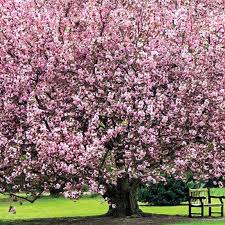Kwanzan Flowering Cherry
Prunus serrulata 'Kwanzan'
Prunus serrulata 'Kwanzan'
|
Foliage: Dark green
Fall Foliage: Yellow/Bronze Fruit: Sterile, typically no fruit Flower: Pink Habit/Form: Upright, Spreading Uses: Accent, Shade |
Zone Hardiness: 6
Plant Height: 30 ft Plant Width: 30ft Light: Sun Growth Rate: Medium |
'Kwanzan' has always been one of the most popular cherry trees. When it's in bloom, it's spectacular! In early spring, distinctive cherry red flower buds open to fragrant, deep pink, double flowers that resemble carnations. They completely cover the bare upright spreading branches. Their leaves emerge reddish-copper before turning a glossy, deep green in the summer, then turn yellow and bronze in the fall. The smooth dark red bark adds interest to the landscape. It is not particular as to soil pH, but grows best in rich soils. It is highly tolerant of urban pollution and will even thrive in inner city environments, and will benefit from being planted in a relatively sheltered location.
Interesting fact....
On March 27, 1912, Yukio Ozaki, the Mayor of Tokyo, gifted 3,000 ornamental Cherry trees to the people of the United States on behalf of the People of Japan. The first of the trees were planted at the Tidal Basin in Washington, D.C. by First Lady Helen Herron Taft and Viscountess Iwa Chinda (wife of the Japanese ambassador). According to the Central Park Conservancy two of the original Cherry trees are still alive today.
Interesting fact....
On March 27, 1912, Yukio Ozaki, the Mayor of Tokyo, gifted 3,000 ornamental Cherry trees to the people of the United States on behalf of the People of Japan. The first of the trees were planted at the Tidal Basin in Washington, D.C. by First Lady Helen Herron Taft and Viscountess Iwa Chinda (wife of the Japanese ambassador). According to the Central Park Conservancy two of the original Cherry trees are still alive today.


